一.实验代码
import httplib2
import time
import json
class OdlUtil:
url = ''
def __init__(self, host, port):
self.url = 'http://' + host + ':' + str(port)
def install_flow(self, container_name='default',username="admin", password="admin"):
http = httplib2.Http()
http.add_credentials(username, password)
headers = {'Accept': 'application/json'}
flow_name = 'flow_' + str(int(time.time()*1000))
#s2流表
#h2工作时s2端口1流量空闲时下发的流表
h2_to_s2_1 ='{"flow": [{"id": "0","match": {"ethernet-match":'\
'{"ethernet-type": {"type": "2048"}},'\
'"ipv4-source":"10.0.0.2/32","ipv4-destination": "10.0.0.1/32"},'\
'"instructions": {"instruction": [{"order": "0",'\
'"apply-actions": {"action": [{"output-action": {'\
'"output-node-connector": "1"},"order": "0"}]}}]},'\
'"priority": "101","cookie": "1","table_id": "0"}]}'
#h3工作时s2端口1流量空闲时下发的流表
h3_to_s2_1 ='{"flow": [{"id": "1","match": {"ethernet-match":'\
'{"ethernet-type": {"type": "2048"}},'\
'"ipv4-source":"10.0.0.3/32","ipv4-destination": "10.0.0.1/32"},'\
'"instructions": {"instruction": [{"order": "0",'\
'"apply-actions": {"action": [{"output-action": {'\
'"output-node-connector": "1"},"order": "0"}]}}]},'\
'"priority": "101","cookie": "1","table_id": "0"}]}'
mh3_to_s2_1 ='{"flow": [{"id": "1","match": {"ethernet-match":'\
'{"ethernet-type": {"type": "2048"}},'\
'"ipv4-source":"10.0.0.3/32","ipv4-destination": "10.0.0.1/32"},'\
'"instructions": {"instruction": [{"order": "0",'\
'"apply-actions": {"action": [{"output-action": {'\
'"output-node-connector": "1"},"order": "0"}]}}]},'\
'"priority": "100","cookie": "1","table_id": "0"}]}'
#h3工作时s2端口1流量满载时下发的流表
h3_to_s2_2 ='{"flow": [{"id": "2","match": {"ethernet-match":'\
'{"ethernet-type": {"type": "2048"}},'\
'"ipv4-source":"10.0.0.3/32","ipv4-destination": "10.0.0.1/32"},'\
'"instructions": {"instruction": [{"order": "0",'\
'"apply-actions": {"action": [{"output-action": {'\
'"output-node-connector": "2"},"order": "0"}]}}]},'\
'"priority": "101","cookie": "1","table_id": "0"}]}'
mh3_to_s2_2 ='{"flow": [{"id": "2","match": {"ethernet-match":'\
'{"ethernet-type": {"type": "2048"}},'\
'"ipv4-source":"10.0.0.3/32","ipv4-destination": "10.0.0.1/32"},'\
'"instructions": {"instruction": [{"order": "0",'\
'"apply-actions": {"action": [{"output-action": {'\
'"output-node-connector": "2"},"order": "0"}]}}]},'\
'"priority": "100","cookie": "1","table_id": "0"}]}'
#s3流表
s3_1='{"flow": [{"id": "0","match": {"ethernet-match":'\
'{"ethernet-type": {"type": "2048"}},'\
'"ipv4-source":"10.0.0.3/32","ipv4-destination": "10.0.0.1/32"},'\
'"instructions": {"instruction": [{"order": "0",'\
'"apply-actions": {"action": [{"output-action": {'\
'"output-node-connector": "1"},"order": "0"}]}}]},'\
'"priority": "101","cookie": "1","table_id": "0"}]}'
s3_2='{"flow": [{"id": "1","match": {"ethernet-match":'\
'{"ethernet-type": {"type": "2048"}},'\
'"ipv4-source":"10.0.0.1/32","ipv4-destination": "10.0.0.3/32"},'\
'"instructions": {"instruction": [{"order": "0",'\
'"apply-actions": {"action": [{"output-action": {'\
'"output-node-connector": "2"},"order": "0"}]}}]},'\
'"priority": "101","cookie": "2","table_id": "0"}]}'
#s1流表
s1_2To1='{"flow": [{"id": "0","match": {"ethernet-match":'\
'{"ethernet-type": {"type": "2048"}},'\
'"ipv4-source":"10.0.0.2/32","ipv4-destination": "10.0.0.1/32"},'\
'"instructions": {"instruction": [{"order": "0",'\
'"apply-actions": {"action": [{"output-action": {'\
'"output-node-connector": "1"},"order": "0"}]}}]},'\
'"priority": "101","cookie": "1","table_id": "0"}]}'
s1_3To1='{"flow": [{"id": "1","match": {"ethernet-match":'\
'{"ethernet-type": {"type": "2048"}},'\
'"ipv4-source":"10.0.0.3/32","ipv4-destination": "10.0.0.1/32"},'\
'"instructions": {"instruction": [{"order": "0",'\
'"apply-actions": {"action": [{"output-action": {'\
'"output-node-connector": "1"},"order": "0"}]}}]},'\
'"priority": "101","cookie": "1","table_id": "0"}]}'
#h1工作时s1端口2流量空闲时下发的流表
h1_to_s1_2 ='{"flow": [{"id": "2","match": {"ethernet-match":'\
'{"ethernet-type": {"type": "2048"}},'\
'"ipv4-source":"10.0.0.1/32","ipv4-destination": "10.0.0.3/32"},'\
'"instructions": {"instruction": [{"order": "0",'\
'"apply-actions": {"action": [{"output-action": {'\
'"output-node-connector": "2"},"order": "0"}]}}]},'\
'"priority": "101","cookie": "2","table_id": "0"}]}'
mh1_to_s1_2 ='{"flow": [{"id": "3","match": {"ethernet-match":'\
'{"ethernet-type": {"type": "2048"}},'\
'"ipv4-source":"10.0.0.1/32","ipv4-destination": "10.0.0.3/32"},'\
'"instructions": {"instruction": [{"order": "0",'\
'"apply-actions": {"action": [{"output-action": {'\
'"output-node-connector": "2"},"order": "0"}]}}]},'\
'"priority": "100","cookie": "3","table_id": "0"}]}'
#h1工作时s1端口2流量满载时下发的流表
h1_to_s1_3 ='{"flow": [{"id": "2","match": {"ethernet-match":'\
'{"ethernet-type": {"type": "2048"}},'\
'"ipv4-source":"10.0.0.1/32","ipv4-destination": "10.0.0.3/32"},'\
'"instructions": {"instruction": [{"order": "0",'\
'"apply-actions": {"action": [{"output-action": {'\
'"output-node-connector": "3"},"order": "0"}]}}]},'\
'"priority": "101","cookie": "2","table_id": "0"}]}'
mh1_to_s1_3 ='{"flow": [{"id": "3","match": {"ethernet-match":'\
'{"ethernet-type": {"type": "2048"}},'\
'"ipv4-source":"10.0.0.1/32","ipv4-destination": "10.0.0.3/32"},'\
'"instructions": {"instruction": [{"order": "0",'\
'"apply-actions": {"action": [{"output-action": {'\
'"output-node-connector": "3"},"order": "0"}]}}]},'\
'"priority": "100","cookie": "3","table_id": "0"}]}'
headers = {'Content-type': 'application/json'}
num=0
#下发流表,地址由ODL上获得
#下发s1与s3的流表
response, content = http.request(uri='http://127.0.0.1:8181/restconf/config/opendaylight-inventory:nodes/node/openflow:1/flow-node-inventory:table/0/flow/0', body=s1_2To1, method='PUT',headers=headers)
response, content = http.request(uri='http://127.0.0.1:8181/restconf/config/opendaylight-inventory:nodes/node/openflow:1/flow-node-inventory:table/0/flow/1', body=s1_3To1, method='PUT',headers=headers)
response, content = http.request(uri='http://127.0.0.1:8181/restconf/config/opendaylight-inventory:nodes/node/openflow:3/flow-node-inventory:table/0/flow/0', body=s3_1, method='PUT',headers=headers)
response, content = http.request(uri='http://127.0.0.1:8181/restconf/config/opendaylight-inventory:nodes/node/openflow:3/flow-node-inventory:table/0/flow/0', body=s3_2, method='PUT',headers=headers)
#s2调用h2到1的流表
response, content = http.request(uri='http://127.0.0.1:8181/restconf/config/opendaylight-inventory:nodes/node/openflow:2/flow-node-inventory:table/0/flow/0', body=h2_to_s2_1, method='PUT',headers=headers)
while num < 4 :
s1_uri = 'http://127.0.0.1:8181/restconf/operational/opendaylight-inventory:nodes/node/openflow:1/node-connector/openflow:1:2'
s2_uri = 'http://127.0.0.1:8181/restconf/operational/opendaylight-inventory:nodes/node/openflow:2/node-connector/openflow:2:1'
#获取s1端口2的流量
response, content = http.request(uri=s1_uri, method='GET')
content = json.loads(content)
statistics = content['node-connector'][0]['opendaylight-port-statistics:flow-capable-node-connector-statistics']
s1_bytes1 = statistics['bytes']['transmitted']
#0.5秒后再次获取
time.sleep(0.5)
response, content = http.request(uri=s1_uri, method='GET')
content = json.loads(content)
statistics = content['node-connector'][0]['opendaylight-port-statistics:flow-capable-node-connector-statistics']
s1_bytes2 = statistics['bytes']['transmitted']
s1_speed=float(s1_bytes2-s1_bytes1)/0.5
if s1_speed !=0 :#获取有效的速度
print ('s1端口2速度:')
print s1_speed
#在检测到s1端口2流量空闲时发的流表
if s1_speed < 1000 :
print(' s1端口2空闲,h1数据包改为往s1端口2通过')
response, content = http.request(uri='http://127.0.0.1:8181/restconf/config/opendaylight-inventory:nodes/node/openflow:1/flow-node-inventory:table/0/flow/2', body=h1_to_s1_2, method='PUT',headers=headers)
response, content = http.request(uri='http://127.0.0.1:8181/restconf/config/opendaylight-inventory:nodes/node/openflow:1/flow-node-inventory:table/0/flow/3', body=mh1_to_s1_2, method='PUT',headers=headers)
#在检测到s1端口2流量满载时发的流表
else :
print(' s1端口2满载,h1数据包改为往s1端口3通过')
response, content = http.request(uri='http://127.0.0.1:8181/restconf/config/opendaylight-inventory:nodes/node/openflow:1/flow-node-inventory:table/0/flow/2', body=h1_to_s1_3, method='PUT',headers=headers)
response, content = http.request(uri='http://127.0.0.1:8181/restconf/config/opendaylight-inventory:nodes/node/openflow:1/flow-node-inventory:table/0/flow/3', body=mh1_to_s1_3, method='PUT',headers=headers)
#获取s2端口1的流量
response, content = http.request(uri=s2_uri, method='GET')
content = json.loads(content)
statistics = content['node-connector'][0]['opendaylight-port-statistics:flow-capable-node-connector-statistics']
s2_bytes1 = statistics['bytes']['transmitted']
#0.5秒后再次获取
time.sleep(0.5)
response, content = http.request(uri=s2_uri, method='GET')
content = json.loads(content)
statistics = content['node-connector'][0]['opendaylight-port-statistics:flow-capable-node-connector-statistics']
s2_bytes2 = statistics['bytes']['transmitted']
s2_speed=float(s2_bytes2-s2_bytes1)/0.5
if s2_speed !=0 :#获取有效的速度
print ('s2端口1速度:')
print s2_speed
#在检测到s2端口1流量空闲时发的流表
if s2_speed < 1000 :
print(' s2端口1空闲,h3数据包改为往s2端口1通过')
response, content = http.request(uri='http://127.0.0.1:8181/restconf/config/opendaylight-inventory:nodes/node/openflow:2/flow-node-inventory:table/0/flow/1', body=h3_to_s2_1, method='PUT',headers=headers)
response, content = http.request(uri='http://127.0.0.1:8181/restconf/config/opendaylight-inventory:nodes/node/openflow:2/flow-node-inventory:table/0/flow/2', body=mh3_to_s2_2, method='PUT',headers=headers)
#在检测到s2端口1流量满载时发的流表
else :
print(' s2端口1满载,h3数据包改为往s2端口2通过')
response, content = http.request(uri='http://127.0.0.1:8181/restconf/config/opendaylight-inventory:nodes/node/openflow:2/flow-node-inventory:table/0/flow/1', body=mh3_to_s2_1, method='PUT',headers=headers)
response, content = http.request(uri='http://127.0.0.1:8181/restconf/config/opendaylight-inventory:nodes/node/openflow:2/flow-node-inventory:table/0/flow/2', body=h3_to_s2_2, method='PUT',headers=headers)
odl = OdlUtil('127.0.0.1', '8181')
odl.install_flow()
二.实验场景

服务器h2 h3上各自有不同的服务,h1是客户端。实现一个负载均衡的北向程序,当h2和h3向h1传输数据时,北向应用根据链路的使用状况动态的调整路由规则。
主要思路:过一定的时间后,下发新的流表,使得流量流向另一个交换机,从而实现负载均衡。类似于轮询法。
三.视频演示
1.打开ODL
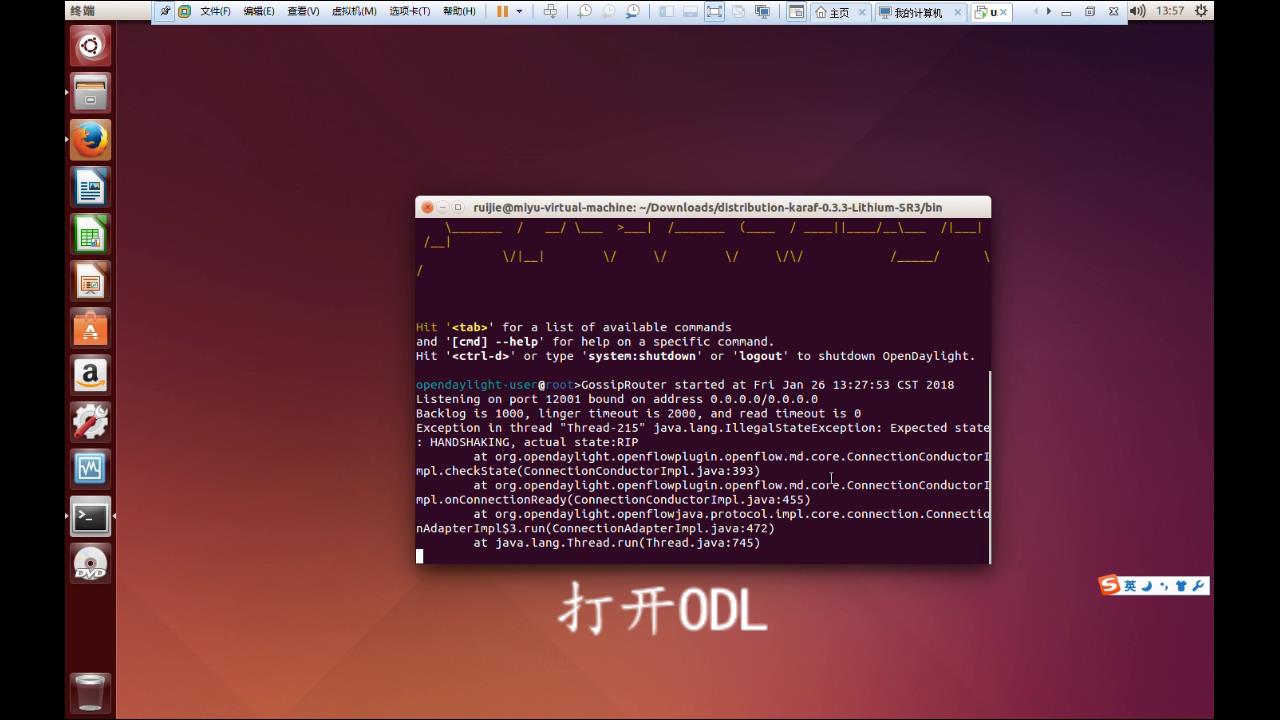
2.查看拓扑
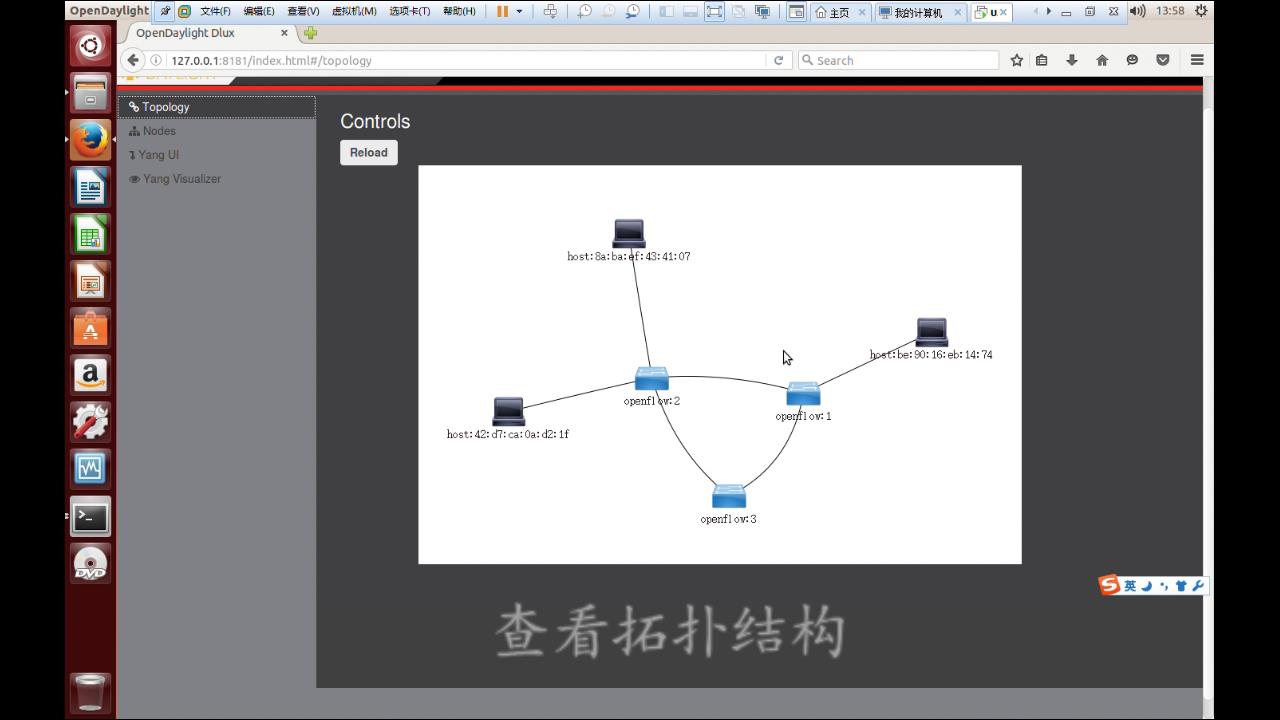
3.查看拥塞状况
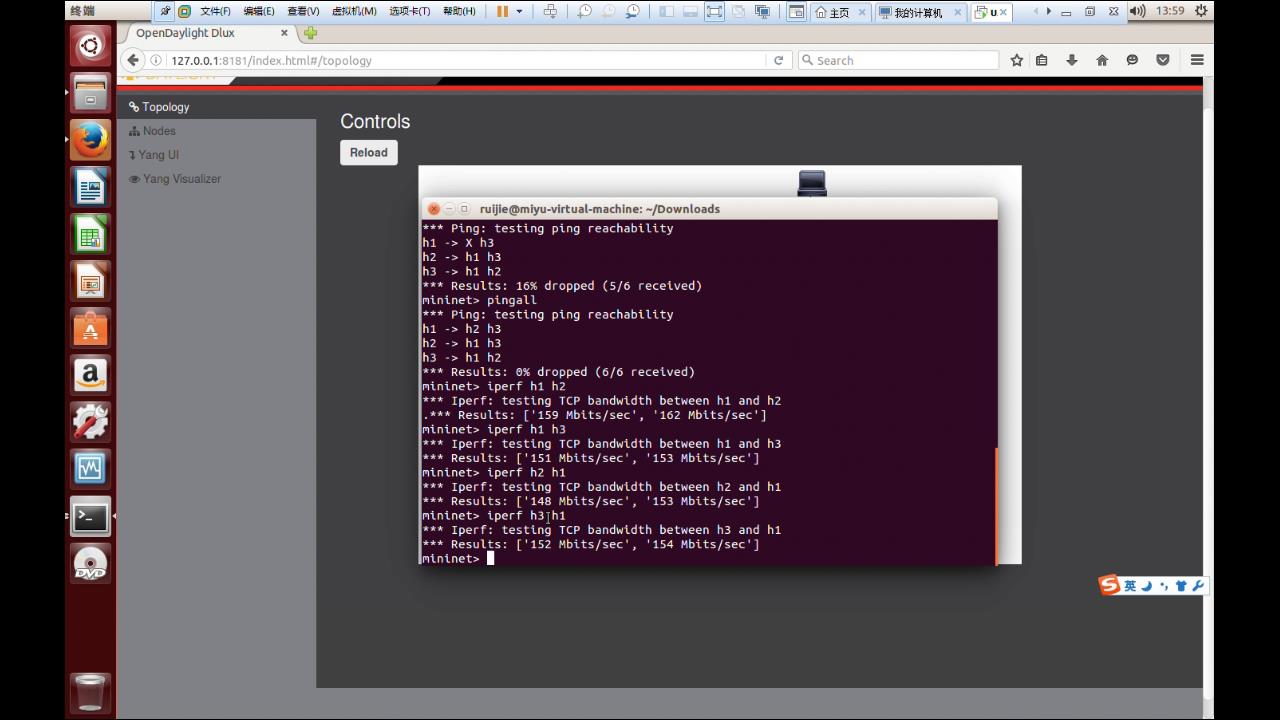
4.调用负载均衡
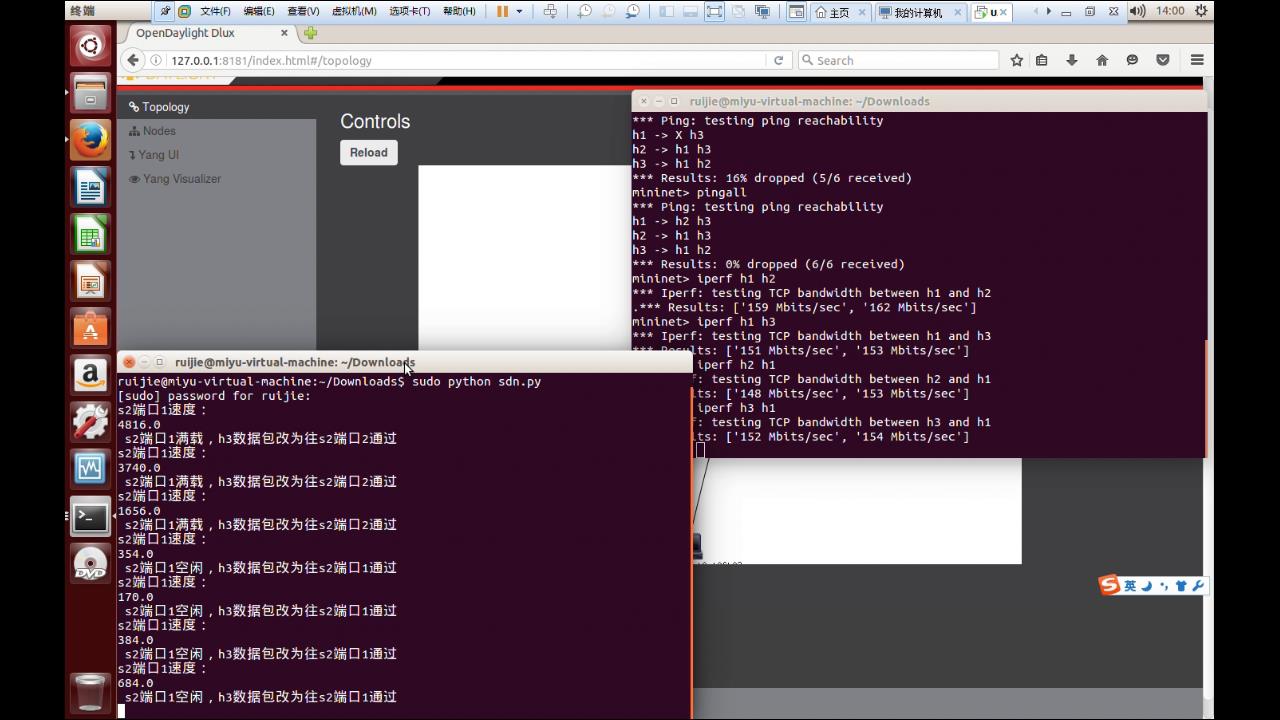
5。负载均衡调用后的结果
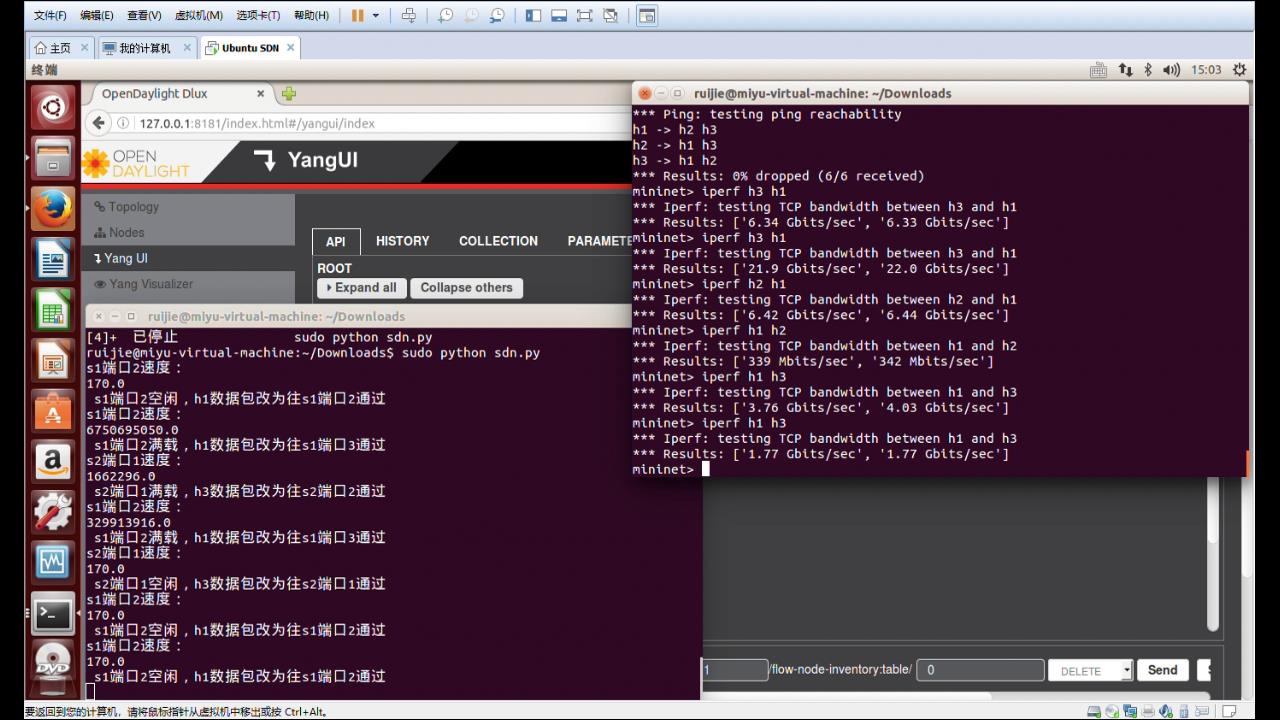
三.小组分工
负责查找相关资料,与小组成员一起完成代码的编写,使其可以成功下发流表实现负载均衡,后期视频的剪辑。
四.课程总结
1.了解了什么是 SDN ,SDN 的基本思想、特点
ODL设计的三个层次
SDN 的应用领域
openflow多级流表机制的优点
opendaylight控制器
2.掌握了在mninet上创建拓扑并通过floodlight验证器正确
运用ODL控制器下发流表并通过OVS命令查看验证
运用Postman通过ODL的北向接口下发流表
运用Wireshark抓包验证拓扑结构的正确性
3.ECMP与负载均衡
对ECMP与负载均衡的定义及实现有了充分的掌握,可以实现较简单的负载均衡场景,理解了几种负载均衡的简单算法以及对负载均衡的优化。


 posted on
posted on

